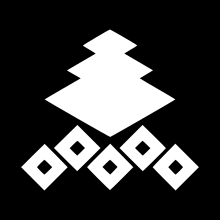Miyoshi (clan)
The Miyoshi ( Japanese 三好 氏 Miyoshi-shi ) were a family of the Japanese sword nobility ( Buke ) , which was derived from the Ogasawara and from the Seiwa-Genji .
genealogy
At the beginning of the 14th century, Ogasawara Nagafusa settled on Shikoku . 8th generation descendants came to the Miyoshi area in Awa Province , adopted the name and served the Hosokawa , who were rulers of Shikoku at the time.
- Nagateru (長 輝; † 1520), who was also called Yukinaga, was Chikuzen no Kami (筑 前 の 上). When the Hosokawa split up after the death of Hosokawa Masamoto in 1507, he attacked Hosokawa Sumiyuki near Kyōto, defeated him and got the son Sumimoto adopted by Masamoto to be named Kanryō. In the following year returned Ōuchi Yoshioki (大 内 義興; 1477-1529) with the deposed Shogun Ashikaga Yoshitane back to Kyoto. Nagateru tried in vain to prevent this: he was beaten and had to return to Awa with Sumimoto. In 1511 he shaved his head and called himself Ki-un. Then he brought together an army again, marched against Kyoto, also came to the city, but was then repulsed by Asakura Takakage in 1519 . Waiting in vain for Sumioto's support, he was attacked and finally beaten. He then committed suicide in the temple of Chion .
- Masanaga (政 長; † 1549), a brother of Nagateru, was Ehizen no Kami (越 前 の 上). He shaved his head and called himself Sōsan and became a monk. He was beaten by Chōkei , together with Hosokawa Harumoto (1514-1563), fell among robbers and lost his life.
- Nagamoto (長 元; † 1532), Nagateru's eldest son, who was initially called Motonaga, became Chikuzen no Kami (筑 前 の 上). In 1520 he marched with the Hosokawa Army in Kyoto, whereupon the Shogun fled to Awa and was replaced by Ashikaga Yoshiharu . In 1532 Nagamoto shaved his head and called himself Kai-un. Some time later he was slandered at Hosokawa Harumoto, whereupon he was killed in the Hongan-ji temple . More than 70 of his followers then committed suicide.
- Chōkei (長慶, 1523–1564), Nagamoto's eldest son, was initially called Norinaga and was Chikuzen no Kami. At the age of 17, with the support of his uncle Masanaga and Matsunaga Hisahide , he marched into the provinces of Kinai (機 内). From 1548 he called himself Chōkei. When he got into an argument with Masanaga, he asked Hosokawa Harumoto's permission to raise troops in Settsu , Izumi and Kawachi provinces . However, this did not agree to the request, but took sides for Masanaga. Chōkei, upset, immediately attacked Masanaga and defeated him. Then he installed Ujitsuna as head of the House of Hosokawa and besieged Harumoto in 1549 in his Miyake Castle. But he did not dare to drive his former master to suicide, but turned again against Masanaga, whom he was able to beat again. Harumoto fled to Ōmi Province and asked Shogun Ashikaga Yoshiteru for help. In the meantime, Chōkei invaded Kyoto in 1550 and then entrusted the city of Matsunaga to Hisahide. He then besieged Hatakeyama Takamasa and captured its Iimori castle in Kawachi province, which he then took over himself. Takamasa withdrew to the province of Kii , raised new troops and then attacked Chōkei. But he was beaten again, and a peace agreement was reached in Kinai in 1562. The following year, Chōkei's son Yoshioki died from poison that was administered to him by Matsunaga Hisahide. Chōkei then adopted Yoshitsugu, a son of his brother Sogō Kazumasa, but the two never worked well together. Hisahide's influence grew stronger: in 1664 he had Chokei's brother Fuyuyasu killed. Shortly afterwards, Chōkei fell ill and died.
- Jikkyū (實 休; † 1559) was a brother of Chōkei. His real name was Yukitora. He was Buzen no Kami (豊 前 の 上), resided at Miyoshi Castle (Awa). In 1552 he killed Hosokawa Mochitake and made his property his own. Hisamatsu Yoshioki, a vassal of Mochitakes, decided to avenge his master and raised troops. But he was beaten and killed by Jikkyū. The Shogun then sent troops to the province of Awa, now Jikkyū was defeated, where he lost his life.
- Fuyuyasu (冬 康; † 1564), Jikkyū's brother, defended Araki Castle (荒木 城) in Settsu Province. He was killed by Matsunaga Hisahide. Fuyuyasu was an excellent poet.
- Yoshitsugu (儀 次; † 1573), nephew and adopted son of Chōkeis, was influenced by Matsunaga Hisahide. He took part with him in 1565 in the murder of Shogun Ashikaga Yoshiteru and his brother Ashikaga Shuko. After receiving the Takaya Castle (高 屋 城), he fell out with Hisahide. Oda Nobunaga restored peace and in 1568 confirmed the possession of Yoshitsugu, namely half the province of Kawachi with the castle Wakae (若 江城). When Yoshitsugu heard in 1572 that a dispute between Shogun Ashikaga Yoshiaki and Nobunaga had broken out, he took sides with the Shogun. Nobunaga then besieged Wakae and Yoshitsugu committed suicide.
With Yoshitsugu's death in 1573, the Miyoshi gradually disappeared from historical traditions. The last of the family were beaten in Shikoku by Chōsokabe Motochika .
literature
- Edmond Papinot: Miyoshi . In: Historical and Geographical Dictionary of Japan. Reprint of the 1910 edition. Tuttle, 1972, ISBN 0-8048-0996-8 .

